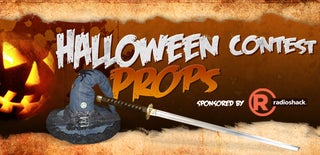Introduction: Creating Any Shape Papier Mâché Mask
This instructable will teach you how to make a light weight and comfortable mask of limited only by your imagination! These can be used as wearable masks, wall hangings, or masks to put somewhere and scare the tar out of a friend, relative or enemy.
While many of us wear masks for Halloween, and believe me this is a great way to make your own unique Halloween mask, it's just pain fun to make a mask anytime of year!
If you create a mask, post it, I would LOVE to see it!
Let's get started....
Edit:
A wonderful instructbale reader pointed out to me that this technique is used by a wonderful artist named Jonni Good, I picked up this way of making masks from a workshop taught by another art teacher, I had no idea that this trickles back down to Ms. Good and her years of work! So do check her out, I did and I was BLOWN AWAY by what she can do!
While many of us wear masks for Halloween, and believe me this is a great way to make your own unique Halloween mask, it's just pain fun to make a mask anytime of year!
If you create a mask, post it, I would LOVE to see it!
Let's get started....
Edit:
A wonderful instructbale reader pointed out to me that this technique is used by a wonderful artist named Jonni Good, I picked up this way of making masks from a workshop taught by another art teacher, I had no idea that this trickles back down to Ms. Good and her years of work! So do check her out, I did and I was BLOWN AWAY by what she can do!
Step 1: Materials Needed
Blue Shop Towels
Plaster of Paris
White School Glue
Vinegar
Thin elastic
Hot Glue Gun
Petroleum Jelly (Vaseline)
Two large bowls
Face/Mask/Face Form (I really like the Make-a-Mask® Reusable Face Forms)
Oil Based Clay (Molding Clay) - The more oil the better
Imagination
Plaster of Paris
White School Glue
Vinegar
Thin elastic
Hot Glue Gun
Petroleum Jelly (Vaseline)
Two large bowls
Face/Mask/Face Form (I really like the Make-a-Mask® Reusable Face Forms)
Oil Based Clay (Molding Clay) - The more oil the better
Imagination
Step 2: Gather Your Materials and Your Idea
Pick out your mask form and your idea for a mask.
Step 3: Build the Mask
With the oil based clay create what you want your mask to look like. The clay is going to act as a mold so, what you create with the clay will be what you mask winds up looking like. Fine details can be added using the mache, and not needed during the clay process.
Don't worry about the clay color, it make no difference at all what colors are being used.
(Side note: I've made several of these, I was bad about taking pictures so you will this process in the form of several different masks)
Don't worry about the clay color, it make no difference at all what colors are being used.
(Side note: I've made several of these, I was bad about taking pictures so you will this process in the form of several different masks)
Step 4: Petroleum Jelly
Once your mask mold is finished, take petroleum jelly and rub it all over your mask. If you are using a form that has empty spots, go ahead and put the petroleum jelly there as well. The petroleum jelly will allow you to remove the paper mache from the mold. Failure to do this process will cause you grief later as you are scraping clay out of your mask. (trust me I did this once by mistake)
Step 5: Twice As Nice
Mask molds can be used more than once! So you could make an army of minions if you felt the need.
Step 6: Papier Mâché
This is a messy process, make sure you are in a work space you don't mind getting dirty or cover things in plastic.
Take the blue shop paper towels and rip them into sheets. Wet the sheets in a bowl and ring them out. This helps break down the binder in the towel. Mix equal amounts of plaster with white glue then add a splash of vinegar. The vinegar keeps the plaster from getting to hard to fast.
I like doing things by cup so:
1 Cup White School Glue
1 Cup Plaster of Paris
1 Teaspoon of Vinegar
Once your mixture is nice and smooth, dip the damp paper towel into the mixture and place over your mask form. Use your fingers to smooth the towel evenly over the mask and get you details in. If you create a wrinkle, and you don't want it there, now is the time to remove it or you are stuck with it.
You CAN tear the towel into strips and dip, but the nice part about this paper towel is it's durable and soft, I would keep it pretty big chunks.
This is when you can add details as well, use small bits of paper to create bumps and so on, then sandwich them in another layer of paper towel.
Two layers is plenty to get a nice sturdy mask. You can make more layers, but I like just sticking with two.
Take the blue shop paper towels and rip them into sheets. Wet the sheets in a bowl and ring them out. This helps break down the binder in the towel. Mix equal amounts of plaster with white glue then add a splash of vinegar. The vinegar keeps the plaster from getting to hard to fast.
I like doing things by cup so:
1 Cup White School Glue
1 Cup Plaster of Paris
1 Teaspoon of Vinegar
Once your mixture is nice and smooth, dip the damp paper towel into the mixture and place over your mask form. Use your fingers to smooth the towel evenly over the mask and get you details in. If you create a wrinkle, and you don't want it there, now is the time to remove it or you are stuck with it.
You CAN tear the towel into strips and dip, but the nice part about this paper towel is it's durable and soft, I would keep it pretty big chunks.
This is when you can add details as well, use small bits of paper to create bumps and so on, then sandwich them in another layer of paper towel.
Two layers is plenty to get a nice sturdy mask. You can make more layers, but I like just sticking with two.
Step 7: Dried
Once the mask is dry, you can remove it from the hump mold.
Carefully take an edge and lift it away from the clay. Don't rush this, you don't want to rip the mask.
It will likely still be soft, right now the clay and petroleum jelly will be keeping the underside moist.
Once the mask is off it's form you can leave it so the back dries.
Carefully take an edge and lift it away from the clay. Don't rush this, you don't want to rip the mask.
It will likely still be soft, right now the clay and petroleum jelly will be keeping the underside moist.
Once the mask is off it's form you can leave it so the back dries.
Step 8: Details
Now, you have an edge around your mask, it's time to trim and cut out what you need. If you have a hole in your mask or it ripped, at this time you can whip up a little of the Papier Mâché mixture, dip a small bit of a paper towel in the mixture, and fill it from behind and let it dry.
Step 9: Paint It! Bling It!
Using acrylic paints paint you mask to get your desired look. You can also add other details. For example, on my cats, I used an x-acto knife to cut holes on it's cheeks then used an 80 lb fishing line to make whiskers. I glued the whiskers in place from behind with a hot glue gun.
Once your paint is dry, you can cut slits and "string" the elastic through to make it a mask. I used a dab of hot glue on the interior of the mask after I knotted the elastic to keep it in place.
Once your paint is dry, you can cut slits and "string" the elastic through to make it a mask. I used a dab of hot glue on the interior of the mask after I knotted the elastic to keep it in place.
Step 10: Gallery
Here are examples of some of my masks as well as some student (camper) masks.
Step 11: Poofrabbit's Tips and Tricks
Take your time, it's not a race. I forget this great tip myself, I get excited, as time goes on I slow down, but learn from me....SLOW DOWN.
Draw it out! It's always helpful to draw out your idea so you have a good solid design.
Plaster gets hot. When plaster gets wet it starts a happy chemical reaction, that reaction creates heat. You can burn yourself with plaster. The vinegar helps with this, but just be mindful so you are not bathing in plaster.
Paint is your friend! If you made an error it's amazing what you can hide with paint!
ENJOY! No matter what, always enjoy what you do. I don't feel there is a right or wrong way to art as long as you are enjoying yourself and learning!
Draw it out! It's always helpful to draw out your idea so you have a good solid design.
Plaster gets hot. When plaster gets wet it starts a happy chemical reaction, that reaction creates heat. You can burn yourself with plaster. The vinegar helps with this, but just be mindful so you are not bathing in plaster.
Paint is your friend! If you made an error it's amazing what you can hide with paint!
ENJOY! No matter what, always enjoy what you do. I don't feel there is a right or wrong way to art as long as you are enjoying yourself and learning!

First Prize in the
Halloween Props Contest

Participated in the
Weekend Projects Contest











